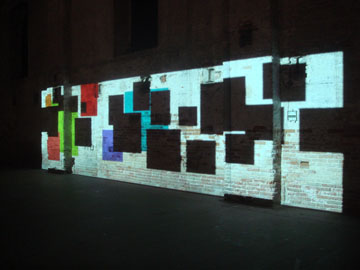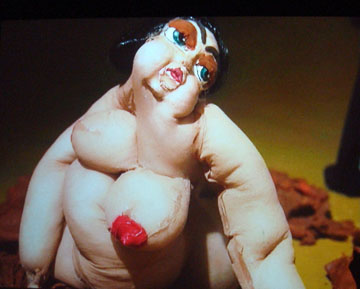
Paul Chan, "Sade for Sade’s Sake," 2009. Three channel shadow projection. Courtesy VVORK (www.vvork.com)
Daniel Birnbaum’s poetic theme of the 53rd Venice Biennale, Making Worlds, is, in some sense, an anti-theme, emphasizing the plurality of art today. Birnbaum’s explanation that “we now live in a multi-centric art world” does not provide much of a compass to viewers who are trying to navigate through a maze of 77-plus pavilions containing hundreds of artworks. In fact, not only does the title fail to orient viewers, but it is also actively disorienting. In a way, there is something paradoxical about the phrase “making worlds”: “making” implies putting things together, cohering, structuring, while “worlds” implies a multiplicity of discrete parts, diffusion, discontinuity.
Come to think of it, my two favorite pieces from the shows that Birnbaum curated (at the Arsenale and the Giardini’s Palazzo delle Esposizioni) explore this notion of simultaneous cohesion and dispersion, using the destructive power of sexuality as a conceit. Paul Chan’s shadow figures in Sade for Sade’s Sake and Nathalie Djurberg’s plasticine puppets in Experimentet show bodies simultaneously merging together in various orgiastic formations while literally breaking apart and dismembering. While the violence of eroticism and the eroticism of violence are age-old themes, I believe that both artists are using this idea to explore larger issues of human struggle.
Paul Chan’s shadow projections interpret Marquis de Sade’s 120 Days of Sodom in 45-second scenes, which he refers to as “stanzas.” The violent whippings, assaults, and gangbangs literally invoke Sade, while the rhythm of the piece reflects what Gilles Deleuze described, in Coldness and Cruelty, as Sade’s “mechanistic approach [to language] imbued with the mathematical spirit.” This mathematical spirit is also reflected in the video’s interposing of geometric shapes, which Chan describes as a means to establish distance. The shadows themselves seem to be more like geometric forms than human beings, as they are reduced to the simplest contours possible. Chan describes coming to the use of shadow projections as a means to “impoverish” his work. I believe that it is this act of impoverishing that allows Sade for Sade’s Sake to function on the level of the symbolic, as opposed to simply illustrating acts of sex and violence.

Still from Nathalie Djurberg's "Experimentet," 2009. Courtesy ArtObserved (www.artobserved.com)
But if Chan’s shadow plays are the ultimate impoverishment of animated videos, Djurberg’s installation is as rich and lush as any moving projection can be (watch her accept the Biennale’s Silver Lion award for the most promising young artist here). While Chan’s shadow projections are created digitally, Djurberg’s hand is evident in every part of her work: in the dozens of carefully sculpted plasticine figures animated by the painstaking process of stop motion claymation, in the painterly sets of each video, and in the installation of human-sized, grotesque flower sculptures that surround the three projections. Described in the Biennale catalogue as a “surrealist Garden of Eden,” Djurberg’s set reflects the lushness of the surrounding Giardini, just as the violent austerity of Chan’s video echoes the industrial harshness of the pointedly unmodified Arsenale. One video in Experimentet shows a woman attempting to evade the advances of an older lecher, and in turn both struggle to escape the forest that begins to attack them. Another film displays a group of Catholic priests detachedly observing a parade of nude women as they erotically clamber over each other’s bodies, melting together and then clawing one other apart until only tattered bits of flesh remain. In a third video, a nude female reclines on a Victorian couch (a la psychoanalysis) in a cave of fecal stalactites, while bits of her body break off one by one and attack her. It seems that this video’s reference to the process of psychoanalysis, like Chan’s invocation of mathemeatics and vague shadows, subtly instructs the viewer to interpret these bizarre violent orgies as symbolic of broader struggles. Sure, the worlds that Djurberg and Chan are making may be horrifying and quite peculiar, but ultimately they address ideas that are profoundly universal. And isn’t that kind of beautiful?




Pingback: Dark Undercurrents in the Hammer Contemporary Collection | Art21 Blog